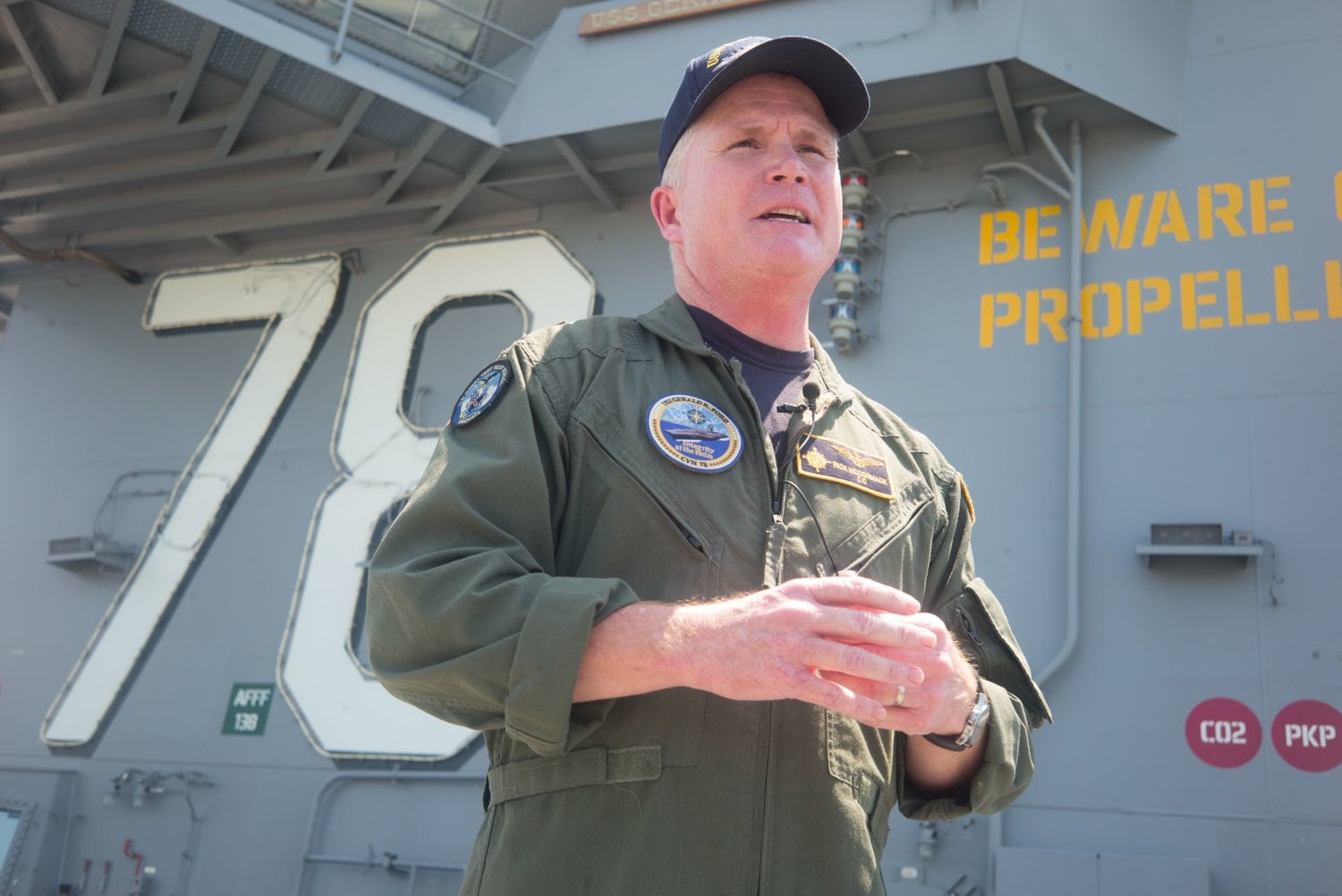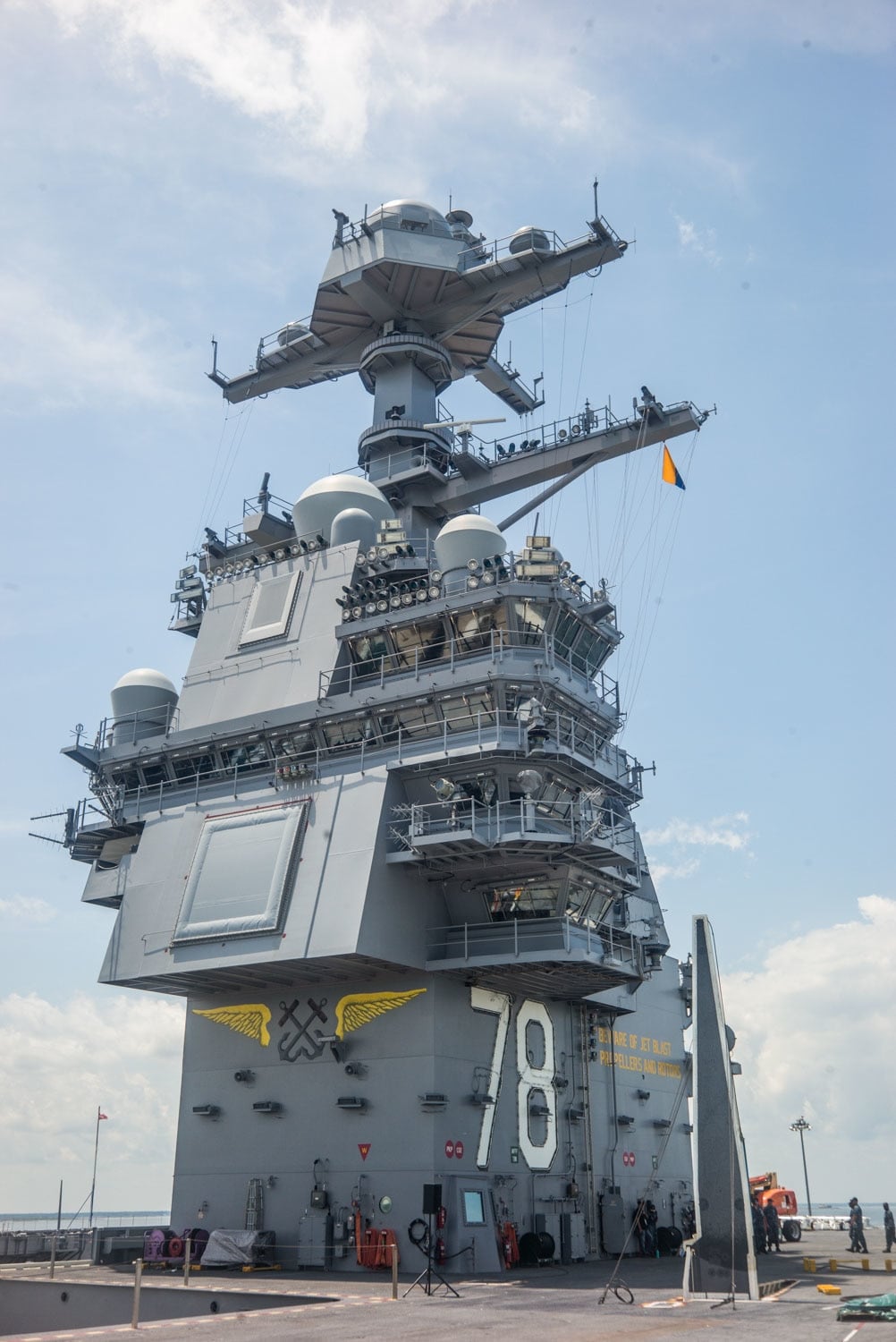President Donald Trump and the Navy’s leadership ushered in a new era in naval aviation on July 22 as they officially commissioned the aircraft carrier Gerald R. Ford, but a large cloud of uncertainty still hovers over the $12.9 billion ship, its high-tech systems and the sailors who will man it.
The nuclear-powered ship — the first in a new class of carriers — joins the feet after spending years over budget and behind schedule. It’s unlikely to deploy for another five years after it undergoes a long “shakedown” period to work out kinks with the shipyard, engineers and crew members.
The ship has still not yet launched or recovered any live aircraft, and big questions surround the electromagnetic catapults and arresting gear that are replacing the traditional steam systems on earlier Navy carriers. Trump criticized those systems in May, saying the electromagnetic technology was “no good” and the Navy should return to “goddamn steam.”
That’s not the only major design change on the Ford. The most visible difference between the Ford and her Nimitz-class predecessors is her island superstructure, which is nearly half the size and placed further aft. There’s also new technology for fueling and weapons handling.
The ship’s crew is about 20 percent smaller — 2,600 sailors vs. 3,200 (ship’s company not counting the airwing) — than those on the Nimitz-class carriers.
Navy leaders theorize those changes will equate to vastly improved effectiveness, specifically a 33 percent increase in the number of missions the ship and its air wing can complete in a single day. And now it’s time for the crew to turn theory into reality.
“The sortie conclusion rate, all that is an objective and our job is to go out there and test that,” said Capt. Richard McCormack, the ship’s commanding officer.

Among the deckplates, the carrier is redefining career paths. As sailors learn the Ford’s new systems, many are wondering whether they will be career Ford-class sailors.
Despite the uncertainty, the attitude among the flight deck crews is one of excitement as they prepare to take Ford back to sea and begin flight deck operations for the first time, said Aviation Boatswain’s Mate 1st Class (AW) Jeremy Stoecklein, the leading petty officer in the division that maintains and operates both electromagnetic systems.
“I’ve already been here four years and I’m ready to get this show on the road,” Stoecklein said.
EMALS
Ford enters the fleet over 42 years after the last new class of carriers — the Nimitz Class — made their debut on May 3, 1975, ushered in by then-President Gerald R. Ford.
The most dramatic innovation for this generation’s carrier is the Electromagnetic Aircraft Launch System, known as EMALS, and the Advanced Arresting Gear, the AAG. They will replace the traditional steam piston systems with one that uses a surge of electrical current to hurl aircraft into the air and halt them abruptly upon return. The aim is to smooth the process of acceleration, putting less stress on the airframes.
Both systems, now on the right track, experienced significant setbacks during development and are major reasons the ship is joining the fleet two years later than planned.
Until now, the ship has only launched “dead loads” — heavy, non-aircraft objects — to test launching capability. McCormack said the ship will go to sea in the next 30 days to launch and recover aircraft for the first time.
“I’m very confident that the EMALS system will do what we need it to do,” he told Navy Times.
“The bottom line is, that is what we are here for. We’re here to test these systems — we have the best engineers in the country, the best operators out here to make sure everything is working. I’ve got a lot of confidence in EMALS.”
The arresting gear, too, has had its share of problems over the past few years, but McCormack believes this system is ready to prove the critics wrong, too.
“I have the utmost confidence that AAG will meet the demand, but again, new system, first of its kind, new technology and we’re here to shake it down and make sure it’s working.”
SUPERSTRUCTURE
By shrinking and moving the ship’s superstructure, the Ford’s designers created more space on the flight deck, which will help increase the sortie rate.
The job of ensuring the efficacy of the flight deck and its crew while increasing the mission rate falls to the ship’s aircraft handler, Lt. Cmdr. Jamie Roman, who cut his teeth on legacy aircraft carriers as a flight deck worker.
“Moving the island further aft gives us more room up forward,” Roman said. “That’s more room to move and park aircraft forward which is better for us than back aft. From a flight deck perspective it gives us more real estate to work with and keeps everything in front of us.

“There’s a lot that goes into it,” he added. “It’s not just the room or the configuration of the flight deck — achieving a sortie rate is teamwork on the flight deck and with the squadrons. Just the way the flight deck is laid out will help make that a possibility, but it’s up to us to make that a reality.”
The further-aft placement of the ship’s island, however, poses challenges for those navigating and steering the ship.
“It’s over two and a half football fields from here to the bow of the ship,” said Quartermaster 1st Class (SW) Jose Triana, leading petty officer in the Ford’s Navigation Department.
“That’s a big difference from a Nimitz-class carrier in calculating the math to safely navigate the ship. It’s challenging to navigate something this big — it’s a lot of math and our crew has been very well trained to handle it.”
Some of the new technology has already received positive feedback from sailors who were underway on the Ford for its first two trials earlier this year.
The Ford’s bridge is driven by technology the Navy is using for the first time.
A highly computerized electronic chart system helps navigate the ship, an innovative fiber optic steering system makes it easier to steer and over 20 redundant control units run the hydraulic steering units which turn the massive rudders under the ship’s stern.
FORD-CLASS CAREERS
For the roughly 2,600 sailors on the Ford, the ship is a career-altering assignment providing unique expertise in the latest technology.
“I was trained in my rating to be a hydraulic and steam mechanic,” Stoecklein said. “Coming here, that changed to needing to learn basic electricity and electromagnetic forces and how opposing forces actually work together to make this technology work. It was a large challenge, but one I can say myself and this crew here has embraced.”
Stoecklein, like many Ford sailors, now finds himself in a unique position. This group, highly trained and experienced in new technologies, could find themselves rotating to shore duty then right back to Ford-class carriers.
“These sailors have helped build this ship and they’re now our experts in these systems that are only on this ship,” McCormack told reporters. “These sailors will remain in demand and as they rotate to other assignments, they could find themselves back here to make the first deployment.”
During the next decade, at least two other Ford-class carriers — the Kennedy and the Enterprise — will likely join the fleet.
DEPLOYMENT DATES
The Naval Sea Systems Command says the ship won’t officially be “operational” for another two and a half years.
The Ford will likely get its own air wing on board and start working up for deployment sometime in 2020, McCormack said, adding that it could be up to five more years before the ship takes its place in the deployment rotation with the Navy’s other carriers.
“That deployment date, somewhere out there past 2021 or 2022, is what is being put out right now,” he said. “But all that’s predicated on how well we do on shakedown in terms of our goals and objectives, and the world can change between now and then and we could get moved forward.”
In the end, McCormack hopes the carrier will be able to propel more aircraft into the air more rapidly than any ship in history. The goal of a 33 percent sortie rate increase translates to better support for troops on the ground.
“What it’s really all about is increasing the numbers of assets overhead to protect the guy on the ground,” McCormack said.





